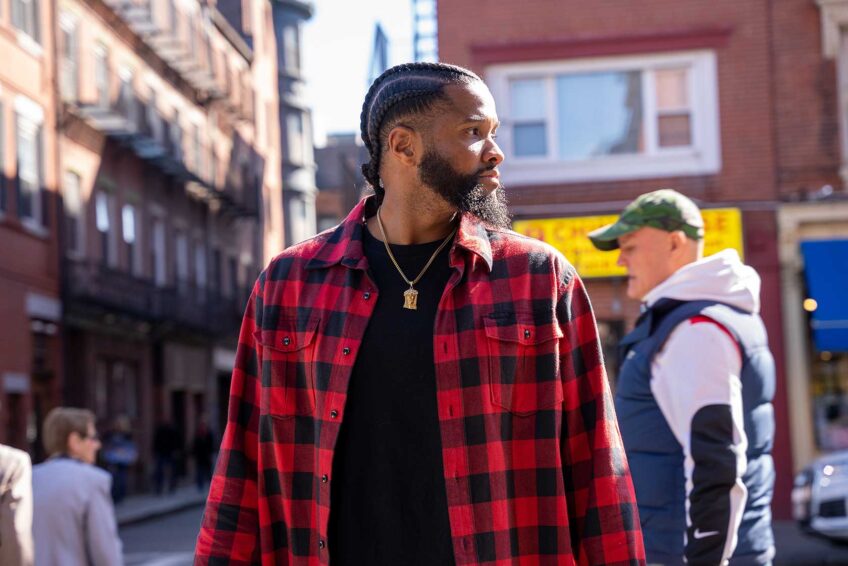Chasten Harmon is excited to play Eponine in the 25th anniversary tour of “Les Miserables.”
Fans of the Tony Award-winning musical, which is running at the Boston Opera House through April 1, know that this vulnerable tomboy is a plum female role.
What may surprise them is how much tougher her character and even the show have become in this commemorative revival. Recently Harmon spoke to the Banner about the fresh approaches to her role and the musical.
By now the plot of the Victor Hugo classic is well known. Jean Valjean works 19 years on a chain gang for merely stealing bread. Eventually he becomes a model citizen and even a mayor.
Inspector Javert, trailing him for a parole violation, becomes obsessed with his capture. Yet no matter how unforgiving Javert is, Valjean reacts with kindness and understanding. During Valjean’s long odyssey of transformation, he becomes a guardian and adopted father to orphaned Cosette, and a protector to Marius, with whom she falls in love. Falling in unrequited love with Marius is Eponine, daughter of crooked innkeepers Monsieur and Madame Threnardier.
Speaking of Eponine, Harmon noted, “Yes, my parents (the Threnardiers) are villains, but I have needs.”
The young actress appreciated directors Lawrence Connor’s and James Powell’s attention to the emotional side of her part.
“I was grateful,” she said, “that the directors had that kind of vision about the character. This is the first time that she had felt love (for Marius).”
The intention, she continued, was to make Eponine more scrappy and animalistic for a very tomboyish role – half scrappy and half hopeful.
Eponine and orphan revolutionary Gavroche, Harmon maintained, “are the ones that the revolution (in 1832 Paris) is fighting for. They’re the first ones to be killed.”
She also liked costume designer Andreane Neofitou’s outfits for her character. At the Revolution-set barricade, she pointed out that Eponine is “dirty and bloody, kind of tattered with the famous red hat and trenchcoat.” Later, “when she comes back in Heaven (along with Cosette’s late mother Fantine to join the soul of Valjean), she has a beautiful white trench coat with a train.”
Harmon especially prized Eponine’s impassioned solo “On My Own.”
Describing the song, she said, “It’s kind of the teenage girl anthem of how life’s unfair.”
By contrast, life seems to be playing fair with Harmon. Besides gaining invaluable experience in two hit musicals — “Les Miserables” and “Hair” in New York, she is heading to Yale in the fall. Harmon is making her Boston debut in “Les Miserables,” but she performed in Dennis, Mass., at Dennis’ Cape Playhouse in a 2009 edition of the musical “Leader of the Pack.”
Even before “Les Miserables,” Harmon gained insight about the challenges of youth from “Hair.”
As a swing – ready for “any different part on any given night” with the recent Tony Award-winning revival, the New York-based mezzo soprano found that this show, which is one of her favorites, spoke resonantly about “rights for different types of people.”
As an African American, (who noted that the black singer Brandy has also played this role) Harmon has found striking affinities between the two shows. “I think the messages are very similar in different packages,” she explained, “rights for the poor and rights for the children who are not educated and have to fend for themselves.”
Directors Connor and Powell have brought a new starkness to the barricade and the attempted revolution in Matt Kinley’s gritty set design. If Kinley’s barricade does not top the revolving original one, it still proves a properly unrewarding terrain for the student revolutionaries. Later, vivid projections evoke the sewers through which Valjean flees with unconscious Marius to safety.
As always, transformed Valjean is the anchor of “Les Miserables,” and J. Mark McVey sings and acts as well as any of his predecessors in the role. His rendition of “Bring Him Home,” is tenacious in its defense of vulnerable Marius and richly plaintive in the later high notes. It’s an electrifying showstopper.
A commemorative edition of “Les Miserables” should recall the greatness of the initial Trevor Nunn and John Caird edition yet bring new insight to Hugo’s masterwork.
The tour at the Opera House happily does both.






